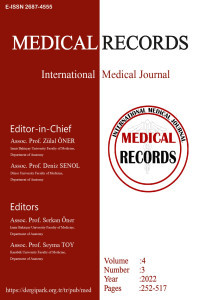Anatomical Analysis of Foramen Magnum: A 3D Slicer CT Study
Anatomical Analysis of Foramen Magnum: A 3D Slicer CT Study
Computed Tomography, Gender, Foramen magnum Morphology, Morphometry,
___
- Arıncı K, Elhan A. Anatomi. 6th edition. Günes Tıp Kitabevleri, Ankara, 2016;33-57.
- Chethan P, Prakash KG, Murlimanju BV et al. Morphological analysis and morphometry of the foramen magnum: an anatomical investigation. Turk Neurosurg. 2012;22:416-9.
- Kumar R, Harode HA, Vora R, Javia M. Variations in the shape of foramen magnum at the base of human skulls among Indians in Rajasthan. Bioinformation. 2022;31:18:488-91.
- Aljarrah K, Packirisamy V, Al Anazi N, Nayak SB. Morphometric analysis of foramen magnum and occipital condyle using CT images for sex determination in a Saudi Arabian population. Morphologie. 2022;106:260-70.
- Richards GD, Jabbour RS. Foramen magnum ontogeny in Homo sapiens: a functional matrix perspective. Anat Rec (Hoboken). 2011;294:199-216.
- Govsa F, Ozer MA, Celik S, Ozmutaf NM. Three-dimensional anatomic landmarks of the foramen magnum for the craniovertebral junction. J Craniofac Surg. 2011;22:1073-6.
- Uthman AT, Al-Rawi NH, Al-Timimi JF. Evaluation of foramen magnum in gender estimation using helical CT scanning. Dentomaxillofac Radiol. 2012;41:197-202.
- Mays S, Cox M. Sex determination in skeletal remains. In: Cox M, Mays S, eds, Human osteology in archaeology and forensic science. London: Greenwich Medical Media Ltd. 2000;117-130.
- Milhorat TH, Nishikawa M, Kula RW, Dlugacz YD. Mechanisms of cerebellar tonsil herniation in patients with Chiari malformations as guide to clinical management. Acta Neurochir (Wien). 2010;152:1117-27.
- Isik N. Chiary malformation and syringomyelia. Türk Nöroşirürji Dergisi. 2013;23:185-94.
- Tunis TS, Sarig R, Cohen H, et al. Sex estimation using computed tomography of the mandible. Int J Legal Med. 2017;131:1691-700.
- Fedorov A, Beichel R, Kalpathy-Cramer J, et al. 3D slicer as an image computing platform for the quantitative imaging network. Magn Reson Imaging. 2012;30:1323-41.
- Martin R, Saller K. Lehrbuch der Antropologie (Band I). Gustav Fischer Verlag, Stuttgart, 1957;492.
- Chan YH. Biostatistics 104: correlational analysis. Singapore Med J. 2003;44:614-9.
- Gruber P, Henneberg M, Böni T, Rühli FJ. Variability of human foramen magnum size. Anat Rec (Hoboken). 2009;292:1713-9.
- Manoel C, Prado FB, Caria PHF, Groppo FC. Morphometric analysis of the foramen magnum in human skulls of brazilian individuals: its relation to gender. Braz J Morphol Sci. 2009;26:104-8.
- Ganapathy A, Sadeesh T, Rao S. Morphometric analysis of foramen magnum in adult human skulls and CT images. Int J Cur Res Rev. 2014;6:11-5.
- Vinutha SP, Suresh V, Shubha R. Discriminant function analysis of foramen magnum variables in south indian population: a study of computerised tomographic images. Anat Res Int. 2018;2018:2056291.
- Güneş EB, Vatansever A. Relations between foramen magnum and associated structures located within the skull base of the Turkish population. Kafkas J Med Sci. 2018;8:207-13.
- Pires LAS, Teixeira ÁR, Leite TFO, et al. Morphometric aspects of the foramen magnum and the orbit in Brazilian dry skulls. Int J Med Res Health Sci. 2016;5:4:34-42.
- Meral O, Belkıs Toklu B, Meydan R, et al. Sex estimation from foramen magnum parameters in adult Turkish population: A computed tomography study. Leg Med (Tokyo). 2020;47:101775.
- Tellioglu AM, Durum Y, Gok M, et al. Suitability of foramen magnum measurements in sex determination and their clinical significance. Folia Morphol (Warsz). 2018;77:99-104.
- Botelho RV, Ferreira ED. Angular craniometry in craniocervical junction malformation. Neurosurg Rev. 2013;36:603-10.
- Ferreira JA, Botelho RV. The odontoid process invagination in normal subjects, Chiari malformation and Basilar invagination patients: pathophysiologic correlations with angular craniometry. Surg Neurol Int. 2015;8:6:118.
- Furtado SV, Thakre DJ, Venkatesh PK, et al. Morphometric analysis of foramen magnum dimensions and intracranial volume in pediatric chiari I malformation. Acta Neurochir (Wien). 2010;152:221-7.
- Taib AA, Greiw AS, Leias EA, et al. Morphometric evaluation of foramen magnum by using computerised tomographic images. International Journal of Clinical Skills. 2019;13:273-7.
- Yayın Aralığı: Yılda 3 Sayı
- Başlangıç: 2019
- Yayıncı: Zülal ÖNER
Placental Histopathological Alterations in COVID-19 Infected Pregnancies
Esra CAN, Işıl TURAN BAKIRCI, Elif Gökçe DEVECİOĞLU GÜRŞEN, Hilal Serap ARIKAN
Osman KULA, Ahmet Onur ÇELİK, Burak GÜNAY
The Effect of Mesh Fixation Methods on Pain Sensation After Laparoscopic Inguinal Hernia Repair
Senem ALKAN AKALIN, Ece ÖCAL, Serap Mutlu ÖZÇELİK OTCU
Retrospective Assessment of Forensic Facts Under 18 Years of Age in İzmir
Ferhat Turgut TUNÇEZ, Ece ERGÜN YEGEN, Derya GÜLMEZ ÖZ, Doğu Barış KILIÇÇIOĞLU
Nurullah DAMBURACI, Barış SEVİNÇ
Burnout and Turnover Intentions of Emergency Department Staff
Tuba EKMEKYAPAR, Seval DEMİR AYDIN
Evaluation of Ventricular Arrhythmia Markers in Obstructive Sleep Apnea Syndrome Patients
